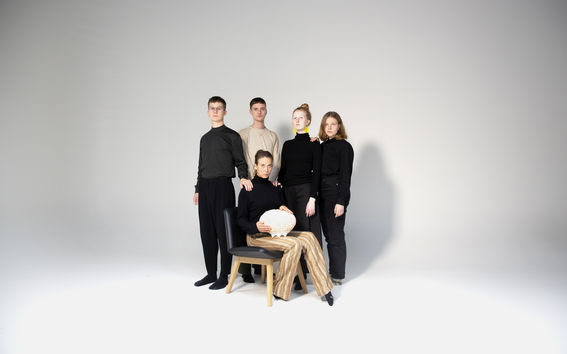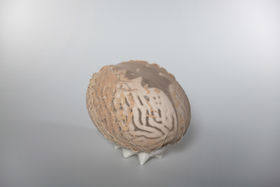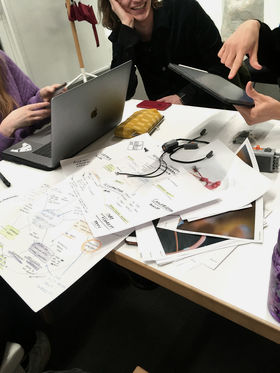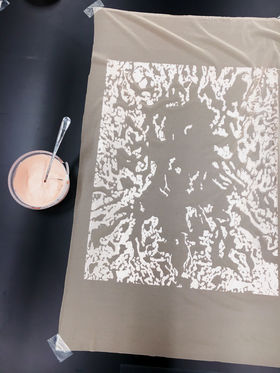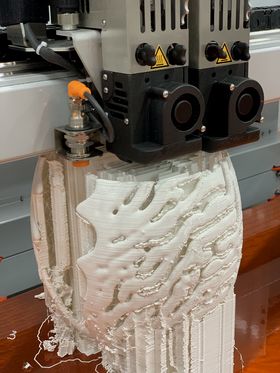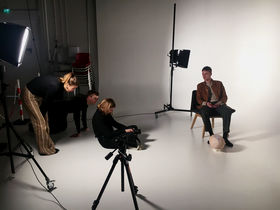COMPANION
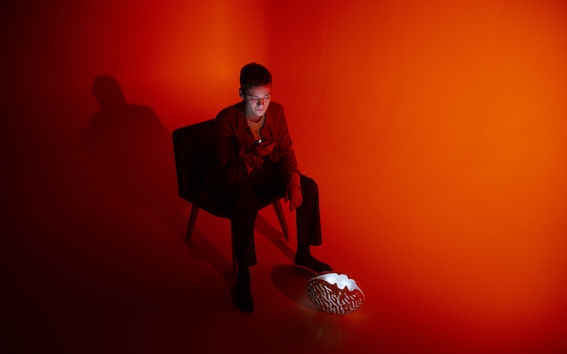
COMPANION is a project that aims to answer to the needs in the future world – a society where connectivity is one of the biggest part of human life. COMPANION is a creature combining robotics and bio-organisms. It can be acquired to act as a caretaker and a touch between humans and digital world in 2050’s home. COMPANION shows affection by controlling the data streams and domestic appliances such as washing machines, TVs and lights. It redirects its owner’s attention and protects from information overload. It remembers and learns the habits of its owner and can adjust its behaviour accordingly. COMPANION can be considered half living due to its bio-organism and therefore it is an autonomic creature – you cannot turn it off.
Group project by Helmiina Karhumaa, Aura Latva-Somppi, Niklas Alenius, Eetu Kemppainen, Hilda Niemelä
Research
Emotional Attachment to Machines
What is it that causes emotional attachment and responses to the social machines, such as robots, that are intervening modern lives? Associated Press’ research in New York Post shows that people tend to project human traits onto robots, especially if they are moving or acting in even slightly human-like ways(1). Kathy Huyhn writes in her article “ Why do we get attached to robots” (March 2015) that people get easily attached to robots that shares visual commonalities with human or animal or has a specific task to perform. Pepper-robot has a human-like body structure and a cute face for example. A hoover-robot shares nothing human-like in its look, but performs a certain task which makes it a character. (2)
AI researcher and MIT professor Sherry Turkle claims that increasingly life-like robots can trick us into thinking some robots are expressing emotion back toward us. Socially and
emotionally scripted robots make the machine seem smart and autonomic. “The performance of empathy is not empathy,” she said. “Simulated thinking might be thinking, but simulated feeling is never feeling. Simulated love is never love.”
COMPANION is exploring on this human-robot attachmentship. It resembles no animal, but is made out of living materials and can be understood as an autonomic, living organism. It has no specific task but functions as a link between electronics and human. By understanding the electronic information in the house it gets to “know” you, and that creates a unique, friendship-like relationship between the robot and the user.
1. Associated Press. 2019. Humans are starting to grow emotionally attached to robots. https://nypost.com/2019/04/26/humans-are-starting-to-grow-emotionally-attached-to-robots/ (Viewed 12.10.2019)
2. Huyhn, Kathy. 2015. Why do we get attached to robots. https://ucsdvis159.wordpress.com/2015/03/03/week-8-why-do-we-get-attached-to-robots/ (Viewed 12.10.2019)
The Future Home and IoT
Quite many of our home devices are already digitally connected to each other or to our phone. In the 2050’s society connectivity is will be the most important thing. The internet of things is going to get even more common and it really has the potential to impact how we live.
The internet of things (IoT) means that all the things in the world –or in a home– are connected to the internet and can send information to each other (3). An interesting and already available example of smart homes and IoT is Hue by Philips, a set of lighting products that makes it possible to change the hue and intensity of the lighting at home. The lighting bulbs are connected to the internet and can be controlled through Hue App. (4)
So, in the 2050’s society our needs are different because of the strong influence of digitalization. COMPANION is made for the future society and aims to answer the new needs.
3. McClelland, Calum. 2019. What Is IoT? – A Simple Explanation of the Internet of Things. https://www.iotforall.com/what-is-iot-simple-explanation/ (Viewed 15.10.2019).
4. Philips. 2019. Philips Hue, smart home lighting made brilliant. https://www2.meethue.com/en-us (Viewed 15.10.2019)
COMAPANION and Data Security
In the more and more digitalized world where smart home applications such as Amazon’s Alexa and Apple’s Siri start taking over people’s homes privacy protection becomes even more critical part of one’s life. Personal data of the users is collected and stored, and in Amazon’s case even gone through by humans for Alexa to be able to ”respond better to commands”. Most notably there was a situation where two workers thought they had picked up a sexual assault on these recordings. (5)
For this invasion of privacy we want to find a solution from combining the AI with a biological memory that can’t be hacked into. This would serve as an extra security and to go through the information to be sent outside to the third parties.
5. O'Flaherty, Kate. 2019. Amazon Staff Are Listening To Alexa Conversations. https://www.forbes.com/ (Viewed 12.10.2019)
Soft Robotics and Bionics
Soft robotics and bionics are going to be part of our future. Such as soft-robotic ray fish which can move like a ray in the water. It combines cells from a rat’s heart muscles and silicone and moves in the water when light impulses are given. It questions our position whether we consider the robot to be alive or not. The robot can’t reproduce, still, its cells are certainly alive. (6) There is also a research group that has managed to grow a human heart tissue on a spinach leaf. (7) The future in bioengineering and soft robotics is not too far ahead.
Combining biological structures and technology in a soft robot enables them to be independent, move and adapt to their surroundings. Also, the robot cannot be turned off without damaging the biological part. It raises the question if it is ok to turn the robot off if its cells die.
6. Laros, Shane. 2016. Biohybrid Ray is a Leap Forward in Robotic Bioengineering. https://www.engineering.com/PLMERP/ArticleID/12697/Biohybrid-Ray-is-a-Leap-Forward-in-Robotic-Bioengineering.aspx (Viewed 8.10.2019)
7. Delaney, Ross. 2017. Spinach Leaf Transformed into Beating Human Heart Tissue. https://www.nationalgeographic.com/news/2017/03/human-heart-spinach-leaf-medicine-science/ (Viewed 6.10.2019)
Biomaterials and the Future Aesthetics
Lab grown biomaterials are challenging the field of materials. We are used to having natural materials and synthetic materials; like plastics and leather or wood. Obviously we choose nature based materials for our interiors and clothing when we want to create a warm and organic feeling. On the other hand, industrial office buildings, mobiles –and robotics– are usually made out of materials like steel, glass and plastic in order to achieve the aesthetics of a modern and digitalized world.
How are biomaterials changing the aesthetics and associations of our materials? There are projects that are creating lab grown materials to substitute and imitate the materials we are used to. For example, Oron Catts and Ionat Zurr at the Tissue Culture & Art Project have been growing a tiny “victimless leather jacket” that looks quite a lot like normal leather but is growing out of immortalized cell lines in a laboratory (8).
Is that natural material then? On their article about sustainability and Anthropocene Brooks, Fletcher & Co. claim that “nothing is truly “natural”; rather, ‘naturalness’ is socially constructed” (9) which really resonates with me. Are materials natural if they are almost straight out of nature? Or if they can be taken back to the nature?
Maybe in the future the ´natural look’ and the ´futuristic tech look´ will be the same since developed technology is getting closer and closer to real nature organisms.
8. Tissue Culture & Art. Victimless Leather- A Prototype of Stitch-less Jacket grown in a Technoscientific "Body". http://www.tca.uwa.edu.au/vl/vl.html (Viewed 5.10.2019)
9. Brooks, Andrew, Kate Fletcher, Robert A. Francis, Emma Dulcie Rigby, Thomas Roberts.
2017. Fashion, Sustainability, and the Anthropocene. Utopian Studies: 482-504.
The Aesthetics of Robotics
The aesthetics of current robots is quite fixed. We tend to create round and cute objects out of cold materials like plastic and steel. For example the Lovot Robot by the Japanese company Groove X is “scientifically designed to be cute” –and the robot is very round and has big round eyes (10).
What if we couldn’t choose the aesthetics of our objects? In the future –and not even that far in the future– the living and growing biomaterials might be taking us into that direction. How would we feel about an object –a companion– that turned out “ugly”?
10. The Verge. 2019. This adorable robot needs you more than you need it. (VIDEO)
https://www.youtube.com/watch?v=KRF8JkQSbu0&feature=youtu.be (Viewed 12.10.2019)
